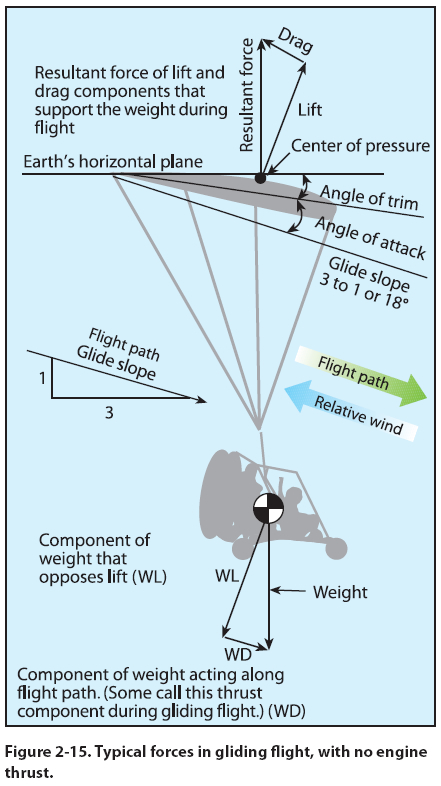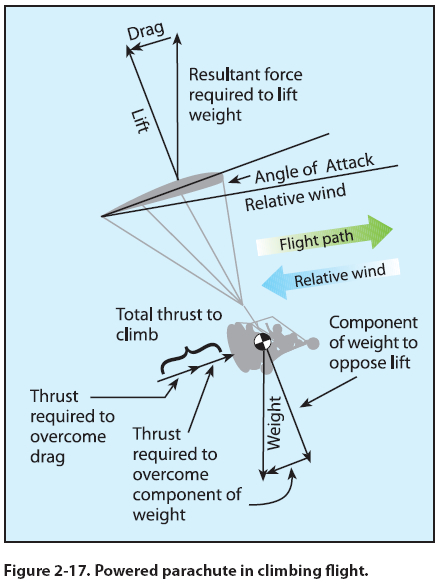Chapter 2 - Aerodynamics of Flight
Weight
Weight is a measure of the force of gravity acting upon
the mass of the PPC. It is the force that opposes lift,
and acts vertically downward through the aircraft’s
center of gravity. Weight consists of everything directly
associated with the powered parachute in flight:
the combined load of the total PPC (wing, risers, engine,
cart, fuel, oil, etc.), people (clothing, helmets,
etc.), and baggage (charts, books, checklists, pencils,
handheld GPS, spare clothes, suitcase, etc.). In stabilized
level flight, when the vertical component of lift
is equal to the weight force, the PPC is in a state of
equilibrium and neither gains nor loses altitude.
Because the trim angle is set at the factory, the PPC
airspeed is predetermined, before takeoff, by the
weight of the aircraft and the wing design. The more
weight, the more forward airspeed is generated.
Therefore, gravity is the primary force for creating
forward speed — pulling the wing through the relative
wind while airborne. The forces in gliding flight are very similar to those for an airplane or gliding
sailplane. [Figure 2-15] Specific numbers presented
in this chapter are examples to serve as a basis to
understand the concepts. Each PPC has unique flying
characteristics and these numbers will be different,
but can be compared to your PPC to provide a
greater understanding of your unique performance.
Note the component of weight acting along the flight
path. This component of weight is called thrust by
some but is more accurately the weight component
providing the forward force.

Thrust
Compared to an airplane, as discussed in Chapter 3
of the Pilot’s Handbook of Aeronautical Knowledge,
thrust serves different purposes in the PPC: (1) it is
used to accelerate the PPC to flying speed while inflating
the wing (2) it is used to climb when at high
thrust, cruise level at medium thrust, and descend at
lower thrust. Variations in thrust have negligible effect on PPC airspeed which remains relatively constant
whether climbing, descending, or in level flight.
When enough thrust is added to produce level flight,
the relative wind stream becomes horizontal with
the earth; the angle of attack and speed remain about
the same. Just as described in the Pilot’s Handbook
of Aeronautical Knowledge for the airplane, thrust
equals total drag for level flight. [Figure 2-16]
When in straight-and-level unaccelerated flight:
LIFT (L) = WEIGHT (W)
and
THRUST = TOTAL DRAG (DT)

When excess thrust is added to produce climbing
flight, the relative air stream becomes an inclined
plane leading upward, while angle of attack and speed
remain about the same. Just as described in the Pilot’s
Handbook of Aeronautical Knowledge for the airplane,
the excess thrust determines the climb rate and
climb angle of the flight path. [Figure 2-17]

|

